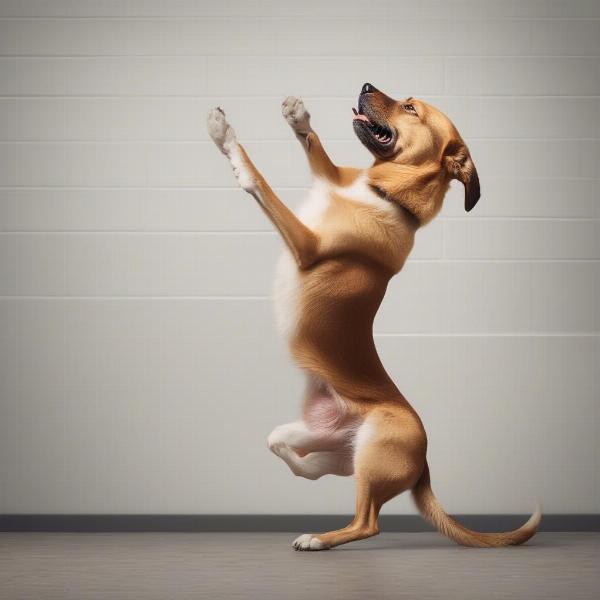Headbutting, or “bunting,” as it’s sometimes called, is a common dog behavior. But why do our canine companions engage in this seemingly strange activity? While it might feel like your dog is trying to give you a headache, headbutting is rarely aggressive. It’s actually a nuanced form of communication, and understanding the reasons behind it can deepen your bond with your furry friend. This article explores the various reasons why your dog might headbutt you, providing insights into canine behavior and communication.
Decoding the Headbutt: Affection, Attention, or Something Else?
A dog headbutt can signify several things, from a simple request for attention to a display of affection. Sometimes, it can also be a sign of something else entirely, such as marking territory or even a medical issue. Deciphering the meaning behind the headbutt depends on understanding the context, your dog’s body language, and the overall situation.
Common Reasons for Headbutting
-
Affection: One of the most common reasons dogs headbutt is to show affection. It’s their way of saying “I love you!” When accompanied by a relaxed body posture, soft eyes, and a wagging tail, a headbutt is a clear sign of canine love and bonding. They are essentially nuzzling you, releasing endorphins in both of you, creating a positive feedback loop of love and connection.
-
Attention-Seeking: Sometimes, a headbutt can simply mean, “Hey, pay attention to me!” If your dog feels ignored or wants something, like a treat, a walk, or a belly rub, they might use a headbutt to get your attention. This is often accompanied by whining, pawing, or bringing you their favorite toy.
-
Scent Marking: Dogs have scent glands on their faces, and headbutting can be a way of transferring their scent to you, marking you as “their” human. This is less about affection and more about claiming you as part of their pack and territory.
-
Information Gathering: Dogs rely heavily on their sense of smell, and headbutting can help them gather information about you. They might be trying to figure out where you’ve been, what you’ve been eating, or even how you’re feeling.
-
Medical Reasons: In rare cases, excessive headbutting, especially against walls or furniture, can be a sign of a medical problem, such as allergies, neurological issues, or even cognitive decline. If your dog’s headbutting seems compulsive or out of character, it’s essential to consult a veterinarian.
How to Respond to Your Dog’s Headbutts
Most of the time, a dog’s headbutt is a harmless and even endearing behavior. You can respond by petting them, giving them a scratch behind the ears, or simply talking to them in a soothing voice. However, if the headbutting is excessive or seems driven by anxiety, it’s best not to encourage the behavior. Instead, try to redirect their attention to a more appropriate activity, such as playing with a toy or going for a walk.
When to Consult a Veterinarian
While headbutting is usually a normal behavior, it’s important to be aware of any changes in your dog’s behavior. If your dog starts headbutting excessively, seems disoriented, or exhibits other unusual symptoms, it’s crucial to consult a veterinarian to rule out any underlying medical conditions.
 Dog Headbutting Wall Indicating Potential Medical Issue
Dog Headbutting Wall Indicating Potential Medical Issue
Conclusion
Understanding why your dog headbutts you is key to strengthening your bond. By paying attention to the context and your dog’s body language, you can decipher the meaning behind this quirky canine behavior and respond accordingly. Whether it’s a sign of affection, a plea for attention, or simply a way of gathering information, a headbutt is just another way your dog communicates with you, expressing their unique personality and strengthening the connection you share.
FAQ
- Is it okay to let my dog headbutt me? Generally, yes. Unless it’s excessive or aggressive, headbutting is a harmless and natural dog behavior.
- What if my dog headbutts me too hard? If your dog’s headbutts are painful, you can gently push them away and say “no” firmly.
- Can headbutting be a sign of aggression? Rarely. Headbutting accompanied by growling, bared teeth, or a stiff posture could be a sign of aggression.
- Why does my dog headbutt other dogs? Dogs might headbutt other dogs as a form of play, greeting, or even a mild dominance display.
- Should I be concerned if my dog headbutts furniture? Occasional headbutting against furniture is usually not a cause for concern. However, frequent or forceful headbutting could be a sign of a medical problem.
- How can I tell if my dog is headbutting out of affection? Affectionate headbutts are usually gentle and accompanied by other signs of affection, such as licking, tail wagging, and a relaxed posture.
- What should I do if my dog suddenly starts headbutting excessively? Consult a veterinarian to rule out any underlying medical conditions.
About ILM Dog
ILM Dog is your go-to resource for all things dog-related. We offer expert advice on dog breeds, health, training, nutrition, grooming, and much more. Whether you’re a seasoned dog owner or a first-timer, ILM Dog has everything you need to provide the best possible care for your furry friend. Contact us for more information: Email: [email protected], Phone: +44 20-3965-8624.